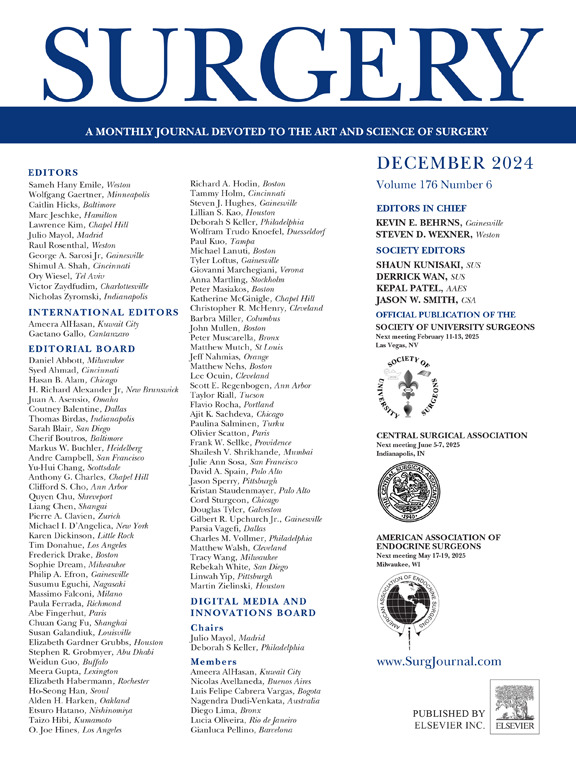OptLung: An online predictive model for optimizing therapeutic strategies for second primary lung cancer in cancer survivors
IF 3.2
2区 医学
Q1 SURGERY
引用次数: 0
Abstract
Background
Advances in cancer detection and treatment have significantly improved survival rates and led to an increasing prevalence of the second primary lung malignancy among cancer survivors. The prognosis and optimal treatment strategies of second primary lung malignancy differ substantially from those of first primary lung cancers. Existing prognostic models primarily focus on the first primary lung cancers and offer limited guidance for personalized treatment strategies to patients with second primary lung malignancy.
Methods
We identified patients with second primary lung malignancy who met the inclusion criteria in the Surveillance, Epidemiology, and End Results database. Machine learning models, including classification trees, K-nearest neighbors, gradient boosting machine, neural network, and random forest, were developed to predict 1- to 5-year overall survival and cancer-specific survival. The dataset was split into training and testing sets (8:2 ratio), and the model performance was evaluated using area under the curve, accuracy, sensitivity, specificity, precision, F1 scores, and Brier scores. By comparing survival outcomes between the concordant group (patients whose treatments aligned with model recommendations) and the discordant group (patients whose treatments did not), the ability of models to recommend optimal therapeutic strategy was validated.
Results
Among 32,370 patients with second primary lung malignancy from the Surveillance, Epidemiology, and End Results database, factors associated with worse prognosis included older age, male sex, White race, unmarried status, nonadenocarcinoma histology, advanced T and N stages, and advanced American Joint Committee on Cancer stage. Conversely, smaller tumor size, surgical intervention, chemotherapy, and radiotherapy were associated with improved prognosis. The gradient boosting machine model exhibited superior predictive performance for overall survival and cancer-specific survival and achieved area under the curve values exceeding 0.84 across all time points. Therapeutic recommendations from models proved effective because the concordant group demonstrated significantly better overall survival and cancer-specific survival than the discordant group. To enhance the clinical applicability of treatment recommendations by machine-learning models, an interactive web-based tool, OptLung (https://hznuduan.shinyapps.io/OptLung/), was developed.
Conclusion
This study used machine-learning models to accurately predict the survival curve of patients with second primary lung malignancy. These models built a user-friendly web-based platform where clinicians can obtain the optimal therapeutic strategy for patients with second primary lung malignancy.

OptLung:一个在线预测模型,用于优化癌症幸存者的第二原发性肺癌治疗策略
癌症检测和治疗的进步显著提高了生存率,并导致癌症幸存者中第二原发性肺恶性肿瘤的患病率增加。第二原发性肺恶性肿瘤的预后和最佳治疗策略与第一原发性肺癌有很大不同。现有的预后模型主要关注第一原发性肺癌,对第二原发性肺恶性肿瘤患者的个性化治疗策略指导有限。方法选择符合监测、流行病学和最终结果数据库纳入标准的第二原发性肺恶性肿瘤患者。机器学习模型,包括分类树、k近邻、梯度增强机、神经网络和随机森林,被开发用于预测1至5年的总生存率和癌症特异性生存率。将数据集分成训练集和测试集(比例为8:2),并使用曲线下面积、准确性、灵敏度、特异性、精度、F1分数和Brier分数来评估模型的性能。通过比较和谐组(治疗方法与模型建议一致的患者)和不和谐组(治疗方法与模型建议不一致的患者)的生存结果,验证了模型推荐最佳治疗策略的能力。结果来自监测、流行病学和最终结果数据库的32370例第二原发性肺恶性肿瘤患者中,与预后较差相关的因素包括年龄较大、男性、白人、未婚状态、非腺癌组织学、晚期T和N期以及晚期美国癌症联合委员会。相反,较小的肿瘤大小、手术干预、化疗和放疗与预后改善相关。梯度增强机模型对总体生存和癌症特异性生存表现出优越的预测性能,并且在所有时间点上实现了超过0.84的曲线下面积值。模型的治疗建议被证明是有效的,因为和谐组的总生存率和癌症特异性生存率明显优于不和谐组。为了通过机器学习模型提高治疗建议的临床适用性,开发了一个基于网络的交互式工具OptLung (https://hznuduan.shinyapps.io/OptLung/)。结论本研究使用机器学习模型准确预测第二原发性肺恶性肿瘤患者的生存曲线。这些模型建立了一个用户友好的基于网络的平台,临床医生可以获得第二原发性肺恶性肿瘤患者的最佳治疗策略。
本文章由计算机程序翻译,如有差异,请以英文原文为准。
求助全文
约1分钟内获得全文
求助全文
来源期刊

Surgery
医学-外科
CiteScore
5.40
自引率
5.30%
发文量
687
审稿时长
64 days
期刊介绍:
For 66 years, Surgery has published practical, authoritative information about procedures, clinical advances, and major trends shaping general surgery. Each issue features original scientific contributions and clinical reports. Peer-reviewed articles cover topics in oncology, trauma, gastrointestinal, vascular, and transplantation surgery. The journal also publishes papers from the meetings of its sponsoring societies, the Society of University Surgeons, the Central Surgical Association, and the American Association of Endocrine Surgeons.
 求助内容:
求助内容: 应助结果提醒方式:
应助结果提醒方式:


